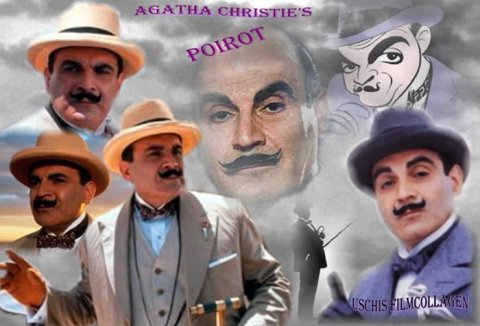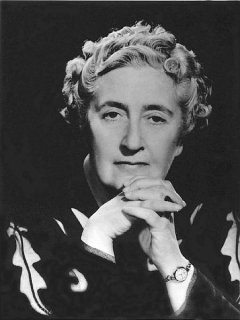Introduction to “Agatha Christie’s Poirot”

According to an unverified source Ushis Filmcollagen apparently has been taken down for violating copyrights. I have no deliberate intention of infringement and if the Agatha Christie estate makes a request for taking the above picture down I of course will.
NB! Spoilers come without warning on the sheets
That said, I of course won’t just give it all away and I’ll try not to reveal any culprits, at least not without a warning first. In the introduction to Christie the culprit is revealed as for the novel The Murder of Roger Ackroyd, so now you’re warned on that one...
Introduction to the TV series with David Suchet
Introduction to Hercule Poirot - coming...
Famous Poirot quotes in the TV series - coming...
List of one-hour episodes and full-length films - coming... maybe...
TV Episode Guide - by year
Works by Christie - coming...
The intro page is in progress - more will be added later
Intro to the TV series with David Suchet
by Sergio Angelini on Screenonline
“Although the novels and short stories featuring the monumentally fastidious and arrogant detective Hercule Poirot were published between 1920 and 1975, producer Brian Eastman and principal scriptwriter Clive Exton set Agatha Christie's Poirot in 1936, to capitalise on the glamorous Art Deco designs of the period. The scripts, including contributions by Anthony Horowitz, Andrew Marshall and David Renwick, occasionally emphasised this by introducing specific 1936 historical references, like the Jarrow March and Fred Perry's win at the French Open.
Mostly, though, the series projects a glossy, generic 1930s atmosphere, offering up for admiration the expensive and beautifully crafted period trappings of the era, including cars, aircraft, fashions and architecture. The décor is also crucial, with the layout of Poirot's Whitehaven Mansions flat (actually Florin Court in Charterhouse Square, near Holborn) central to the episode “The Third Floor Flat” (tx. 5/2/1989). This style is brilliantly evoked in Pat Gavin's animated title sequence and by Christopher Gunning's memorable theme tune.
The series' main strength, however, is its casting - aside from Suchet's splendid, Penguin-like Poirot, Hugh Fraser's car-loving Captain Hastings (always one of the stupidest Watsons in literature) is always sympathetic, and provides a strong comedic foil for the pompous detective. The other recurring characters are Felicity Lemon (Pauline Moran), Poirot's indefatigable secretary, and Chief Inspector Japp (Philip Jackson); both roles have been greatly expanded from the original tales.
After exhausting the short stories, the series turned to the novels, with mixed fortunes. ”Murder on the Links” (tx. 11/02/1996) works extremely well, combining a love story for Hastings and a splendid duel of wits between Poirot and a French police inspector clearly patterned after Georges Simenon's Maigret. Equally good is “The Mysterious Affair at Styles” (tx. 16/9/1990), which went back to the First World War to show Poirot and Hastings' first case. “Hickory, Dickory, Dock” (tx. 12/02/1995), however, feels padded, while Exton's brave attempt to preserve Christie's celebrated surprise ending to “The Murder of Roger Ackroyd” (tx. 02/01/2000) sadly doesn't work.
Recent episodes have turned to Christie's darker, more psychologically penetrating Poirot novels. David Pirie's script for “Sad Cypress” (tx. 26/12/2003) was effectively sombre, while Kevin Elyot's adaptation of “ Five Little Pigs” (tx. 14/12/2003) successfully brought out the story's homosexual subtext, while deftly handling its awkward flashback structure. These have also served to underline the strength and surprising depth with which Suchet, in his multifaceted interpretation, has imbued the role”
to links
to top
Some DVD Collections
Agatha Christie - The Poirot Collection
A collection of DVDs on subscription featuring a 14 pages magazine to each episode giving insights into the programmes, cast and characters of all episodes already broadcast. Now and then you’ll bump into the magazines in here - they all come from Diana in Germany, who kindly and generously as always, offered me to do the hard and time steeling work of making scans and send them to me. And I can only say they are a ‘must have’ for collectors and others interested in getting background stories about the series, the era and Agatha Christie. Check the collection out here - the company only supplies UK, Ireland, South Africa, Australia and New Zealand, but you might be able to get it on eBay also.
Agatha Christie’s Poirot - The Complete Collection (2006)
A collection of 24 DVDs, a few of them have extras. Features all episodes aired in UK from 1989 to 2006, starting with The Adventure of the Clapham Cook and ending with Taken at the Flood. You can see the covers here and get the collection on amazon.co.uk
to links
to top
An introduction to Christie
by Diana Utsch, Germany, 2008
 “The mystery writer Agatha Christie is still called the “Queen of Crime”. Born in Torquay in 1890, she remains one of the most read writers in the world, selling more than 2 billion copies and translated into more than 44 languages. Her copies are only outsold by the Bible and Shakespeare. She has written 69 mystery novels, 19 plays and more than 100 short stories. Her preference of using poison as a murder weapon presented her the title “Queen of Poison”.
“The mystery writer Agatha Christie is still called the “Queen of Crime”. Born in Torquay in 1890, she remains one of the most read writers in the world, selling more than 2 billion copies and translated into more than 44 languages. Her copies are only outsold by the Bible and Shakespeare. She has written 69 mystery novels, 19 plays and more than 100 short stories. Her preference of using poison as a murder weapon presented her the title “Queen of Poison”.
She never had the intention of writing a mystery novel, but it was a wager that her sister Madge offered her, she could not resist. She had written some short stories before, just for fun, and her sister teased her, she could never write a mystery story. Agatha accepted the challenge and started to write her first novel “The Mysterious Affair at Styles”. Because of working as an assistant at a dispensing chemist’s in WWI, she decided to let poison be her first murder weapon. She had a tremendous knowledge of poison and knew exactly how it works.
But then there was the question which kind of detective to choose. She was much influenced by Sir Arthur Conan Doyle and so it had to be a kind of duo like Sherlock Holmes and Dr. Watson. “Who would I have as a detective? I reviewed such detectives as I had met and admired in books. There was Sherlock Holmes, the one and only – I should never be able to emulate him...Then I remembered our Belgian refugees. We had quite a colony of refugees living in the parish of Tor. Why not make my detective a Belgian, I thought? There were all types of refugees. How about a refugee police officer? Not too young a one...” (From: Agatha Christie: An Autobiography).
And so Hercule Poirot was born. Later she admitted that it had been a big mistake to have started with him being old, but no one really cared about it, that Hercule Poirot must have been over 100 years old when it came to the final book “Curtain”. “The Mysterious Affair at Styles” was written in 1917, but not published until 1920. After that she wrote 33 novels and 56 short stories about her character Hercule Poirot.
Her success increased over the next years, until she broke one of the “golden rules” of mystery writing. In the novel “The Murder of Roger Ackroyd” it was the narrator, Dr. Shepard, who committed the murder. Something like that has never been done in a mystery novel before and it caused a scandal. She was supposed to be dismissed from the “Crime Writers Circle” and only the intervention from the other famous “Lady of Mystery”, Dorothy L. Sayers, creator of the detective Lord Peter Whimsey, saved her from that. She claimed that Christie had given the readers the opportunity to solve the crime, but they were not intelligent enough and failed.
The publishing of the novel went together with the mysterious disappearing of Agatha Christie. After a search through all of the country, she was found some days later in a hotel, suffering from amnesia as she said. Critics mentioned it was just a publicity gag for the book, but now it is more obvious that she really had a blackout after discovering that her husband betrayed her.
In 1930 another detective made her first appearance: Miss Jane Marple. Agatha Christie was much more fond of her than of Hercule Poirot. Poirot started to live a life of his own. The editors only wanted Poirot stories, because they were sold at their best. He was the name of the success and with that she began to hate him, which is much more obvious in her late novels. The 1930’s always seem to be the best period of her writing. It’s the era in which she wrote her most famous novels like “Murder on the Orient-Express” (1934), “The ABC Murders” (1936) and “Death on the Nile” (1937).
Christie created the style of the “Closed-Room-Mystery”. A lot of her crimes happen in a closed room like a ship (Nile), a train (Orient-Express) or a locked room (Styles). And it’s her new view onto crime that influenced many other writers, especially the psychological side. Nobody has done such kind of writing before, breaking every rule that is possible, like the crime is committed by everybody, a suicide is staged as murder, a murder is hidden between other murders etc.
During the WWII, Christie became afraid of being killed in the “Blitz”, so she already wrote Poirot’s final case “Curtain”. But she did survive and the book was locked up until a short time before she was going to die.
As mentioned before, she became sick of Poirot. She showed in her last novels how much she hated him up to the end, that he sometimes only appeared at the end of the story. And his character grew darker and darker. He seemed to be stuck in an era that was no longer his.
She allowed herself an alter ego in the stories, by creating the mystery writer Mrs. Oliver. It’s obvious that this is Christie herself. Mrs. Oliver has her first appearance in “Cards on the Table” and was than a regular in the later strories. Her feelings about writing and what the editors have done to her characters, was Christie’s point of view. She even explained why she hated Poirot through her comments about the Finnish detectic Sven. Although, Poirot will always be her biggest success. People even queued in front of the bookshops when a new Poirot novel was announced. The little Belgian was always the favourite of her readers, because of his manners, eccentricities, his politeness and his grace to people.
Privately, Christie was very happily married to Sir Max Mallowan, her second husband, who has been a very well known archealogist. She met him at an dig in Iraq and went with him many times, supporting him in his digs while writing new novels on her typewriter in a tent in the desert. That’s why some Poirot novels have the “Orient touch”, like “Appointment with Death”, “Murder in Mesopotamia” or “Death on the Nile”. She even used genuine people for their characterization. The Mrs. Leidner of “Murder in Mesopotamia” is the wife of her husband’s boss when they met in Mesopotamia.
Agatha Christie died at the age of 85 years in 1976. And her character Poirot died where it all started: at Styles.”
to links
to top
2008 © All rights reserved
Last updated May 2008
